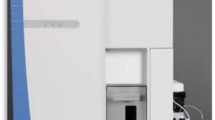Abstract
Porcine relaxin is a 6 kDa peptide hormone of pregnancy with important physiological and pharmacological effects. It contains a number of analogs of which porcine relaxin B29 is one of the most important. To support the development of porcine relaxin B29 as a new drug, we established an UPLC-MS/MS method for its quantitation in dog plasma. Sample preparation by protein precipitation and ion exchange solid phase extraction was followed by UPLC on an XBridge™ BEH300 C18 column at 40 °C in a run time of only 5.5 min. Detection was performed on a Qtrap 6500 mass spectrometer using ESI in the positive ion mode with MRM of the transitions at m/z 831.7 [M+7H]7+ → 505.4 and m/z 1162.4 [M+5H]5+ → 226 for pRLX B29 and internal standard (recombinant human insulin), respectively. The method was linear over the concentration range 30–2000 ng/mL with no matrix effects. Intra- and inter-day precisions were < 15% with accuracies in the range 98.8–100.6%. The method was successfully applied to a pharmacokinetic study in beagle dogs after administration of a 0.15 mg/kg intravenous dose.

Sample preparation and detection procedure.





Similar content being viewed by others
References
Schwabe C, McDonald JK. Relaxin: a disulfide homolog of insulin. Science. 1977;197:914–5.
Sherwood CD, O'Byrne EM. Purification and characterization of porcine relaxin. Arch Biochem Biophys. 1974;160:185–96.
Büllesbach EE, Schwabe C. Naturally occurring porcine relaxins and large-scale preparation of the B29 hormone. Biochemistry. 1985;24:7717–22.
Büllesbach EE, Schwabe C. Preparation and properties of alpha- and epsilon-amino-protected porcine relaxin derivatives. Biochemistry. 1985;24:7722–8.
Bani D, Pini A, Yue SK. Relaxin, insulin and diabetes: an intriguing connection. Curr Diabetes Rev. 2012;8:329–35.
Wong AS, Ho EN, Kwok WH, Leung GN, Shen Y, Qi RZ, Yue SK, Wan TS. Identification of porcine relaxin in plasma by liquid chromatography-high resolution mass spectrometry. Drug Test Anal. 2016. https://doi.org/10.1002/dta.2143.
Dahlke M, Ng D, Yamaguchi M, Machineni S, Berger S, Canadi J, et al. Safety and tolerability of serelaxin, a recombinant human relaxin-2 in development for the treatment of acute heart failure, in healthy Japanese volunteers and a comparison of pharmacokinetics and pharmacodynamics in healthy Japanese and Caucasian populations. J Clin Pharmacol. 2015;55:415–22.
Seibold JR, Korn JH, Simms R, Clements PJ, Moreland LW, Mayes MD, et al. Recombinant human relaxin in the treatment of scleroderma. A randomized, double-blind, placebo-controlled trial. Ann Intern Med. 2000;132:871–9.
Sherwood OD. Relaxin's physiological roles and other diverse actions. Endocr Rev. 2004;25:205–34.
Büllesbach EE, Schwabe C. [A0-phenylalanyl] relaxin (porcine): an active intermediate. Biochem Biophys Res Commun. 1985;126:130–5.
Zhu X, Liu J, Wu J, Cao R, Li T. Quantification of recombinant human relaxin-2 (B-29/A-24) in non-pregnant rat plasma using ultra performance liquid chromatography-mass spectrometry. Anal Methods. 2014;6:2072–9.
Ewles M, Goodwin L. Bioanalytical approaches to analyzing peptides and proteins by LC-MS/MS. Bioanalysis. 2011;3:1379–97.
Charnot A, Gouveia D, Armengaud J, Almunia C, Chaumot A, Lemoine J, et al. Multiplexed assay for protein quantitation in the invertebrate Gammarus fossarum by liquid chromatography coupled to tandem mass spectrometry. Anal Bioanal Chem. 2017;409:3969–91.
Rosting C, Gjelstad A, Halvorsen TG. Expanding the knowledge on dried blood spots and LC-MS-based protein analysis: two different sampling materials and six protein targets. Anal Bioanal Chem. 2017;409:3383–92.
Esposito S, Mele R, Ingenito R, Bianchi E, Bonelli F, Monteagudo E, et al. An efficient liquid chromatography-high resolution mass spectrometry approach for the optimization of the metabolic stability of therapeutic peptides. Anal Bioanal Chem. 2017;409:2685–96.
Bros P, Josephs RD, Stoppacher N, Cazals G, Lehmann S, Hirtz C, et al. Impurity determination for hepcidin by liquid chromatography-high resolution and ion mobility mass spectrometry for the value assignment of candidate primary calibrators. Anal Bioanal Chem. 2017;409:2559–67.
Hess C, Thomas A, Thevis M, Stratmann B, Quester W, Tschoepe D, et al. Simultaneous determination and validated quantification of human insulin and its synthetic analogues in human blood serum by immunoaffinity purification and liquid chromatography-mass spectrometry. Anal Bioanal Chem. 2012;404:1813–22.
Thomas A, Schänzer W, Delahaut P, Thevis M. Immunoaffinity purification of peptide hormones prior to liquid chromatography-mass spectrometry in doping controls. Methods. 2012;56:230–5.
Food and Drug Administration. Guidance for industry: bioanalytical method validation. Center for Drug Evaluation and Research: US Department of Health and Human Services, Food and Drug Administration; 2013. http://www.fda.gov/downloads/drugs/guidancecomplianceregulatoryinformation/guidances/ucm368107.pdf
Acknowledgements
The authors gratefully acknowledge financial support from the National Natural Science Foundation of China (Grant Nos. 81430087, 81473142, 81673396, 81673502, and 81603182).
Author information
Authors and Affiliations
Corresponding author
Ethics declarations
All procedures involving animals in this study were approved by the ethics committee of Jilin University and were performed in accordance with the Guidelines for the Care and Use of Laboratory Animals of Jilin University.
Conflict of interest
The authors declare they have no conflict of interest.
Rights and permissions
About this article
Cite this article
Su, C., Sun, H., Yang, H. et al. A validated UPLC-MS/MS method coupled with protein precipitation and ion exchange solid phase extraction for the quantitation of porcine relaxin B29 in dog plasma and its application to a pharmacokinetic study. Anal Bioanal Chem 409, 6559–6565 (2017). https://doi.org/10.1007/s00216-017-0604-3
Received:
Revised:
Accepted:
Published:
Issue Date:
DOI: https://doi.org/10.1007/s00216-017-0604-3




